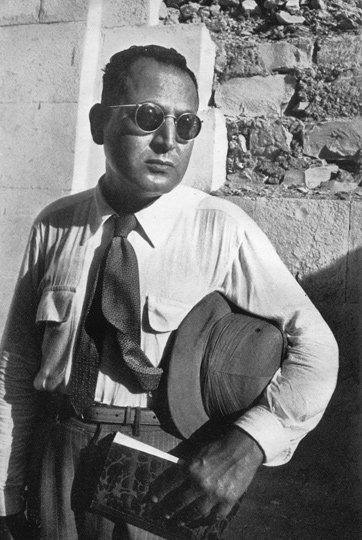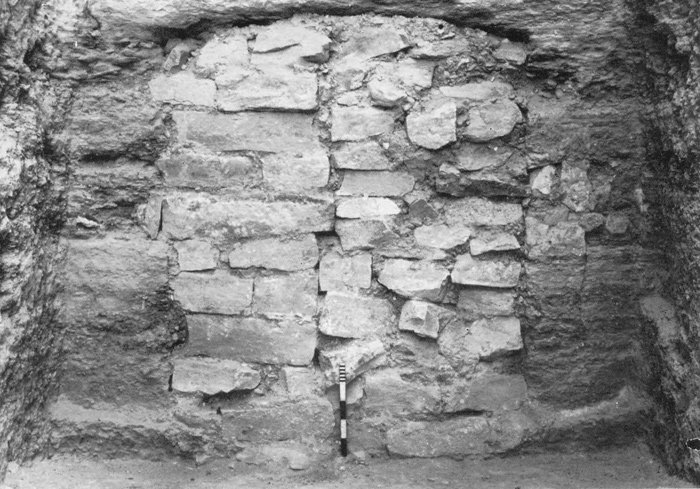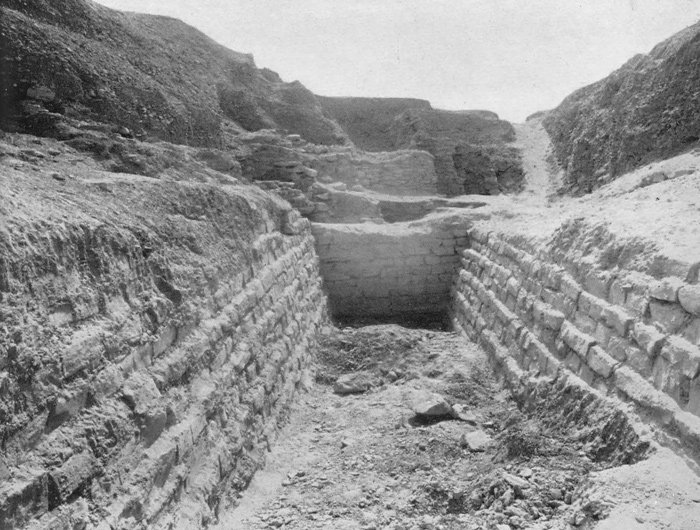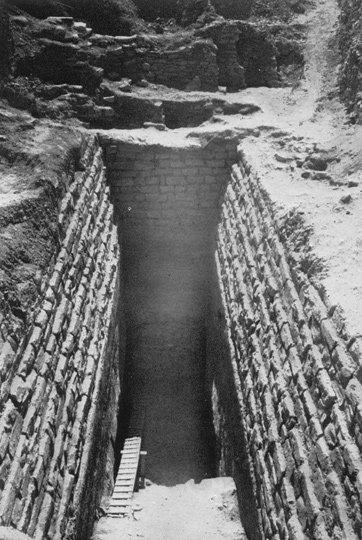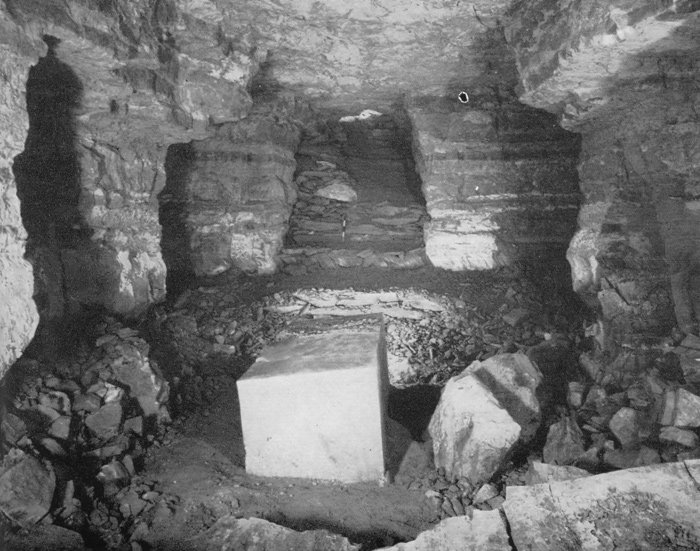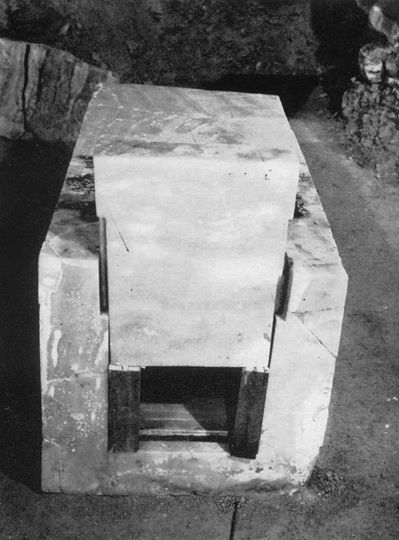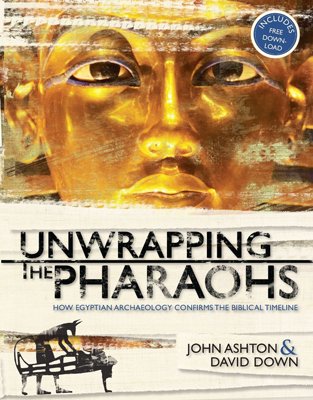
Chapter 3
The Lost Pyramid
Unearthing the evidence of the past can be a very frustrating task, fraught with difficulties and disappointments.
However, some of the greatest finds have been made when archaeologists have attempted to find missing links in the history of an area. One such missing link was found in the early 1950s by the determined efforts of Zakaria Goneim.

Many Egyptian kings were buried in tomb chambers beneath their pyramids. Subterranean passages led to these tomb chambers.
Zakaria began his archaeological career at Saqqara in 1937, when he was appointed assistant archaeologist for the area. After working for some time on the causeway leading to the pyramid of Unas, last king of the 5th Dynasty, he was appointed to the post of Chief Inspector of Antiquities for Upper Egypt, located at Luxor in the south. In 1951, he was transferred to Saqqara once more as Chief Inspector of Antiquities, responsible for the protection and preservation of all the antiquities in the area. Zakaria was thoroughly familiar with the step pyramid of Saqqara, built by King Zoser of the 3rd Dynasty, but he could not understand why no pyramids of Zoser’s successors had been found. He felt sure they were there somewhere and wanted to search for them. In his book The Buried Pyramid he wrote, “It seemed strange to me that in this, the most important necropolis of Memphis, there is only one monument which can definitely be ascribed to a 3rd Dynasty king.”1 His associates were rather skeptical. After all, pyramids can’t very well be hidden, and they were not slow to tell him so. However, Zakaria was undaunted and he set out to prove his point.
Zakaria began his search by making a minute examination of the archaeological areas from north to south, beginning with the Serapeum, the galleries of tombs of the “Apis Bulls,” which were situated to the northwest of Zoser’s step pyramid at Saqqara. Then he scoured the area around the pyramids of Teti and Userkaf, and the step pyramid itself and other minor pyramids, but with no success. Then he noticed that there was an oblong terrace, marked on the maps as a natural plateau. However, Zakaria sensed that it was too well defined to be natural. He approached the Antiquities Department for permission to investigate the area and was granted the princely sum of 600 pounds to commence his work. He began his excavation in September 1951.
Zakaria’s first job was to round up a team of workmen. He preferred to employ men who had had experience with him; so, he arranged for Hofni and Hussein Ibrahim and ten experienced laborers to come from Luxor to work for him. He also employed 20 local laborers to join the party. Next he decided where to start digging. He noticed an outcrop of rubble masonry barely protruding from the surface sand on the western edge of the rectangle and began digging there. He was delighted to find that it was part of a massive wall nearly 66 feet (20 m) in width and 26 feet (8 m) deep. He found it was built on bedrock. Whatever was enclosed within that wall must be of great importance.
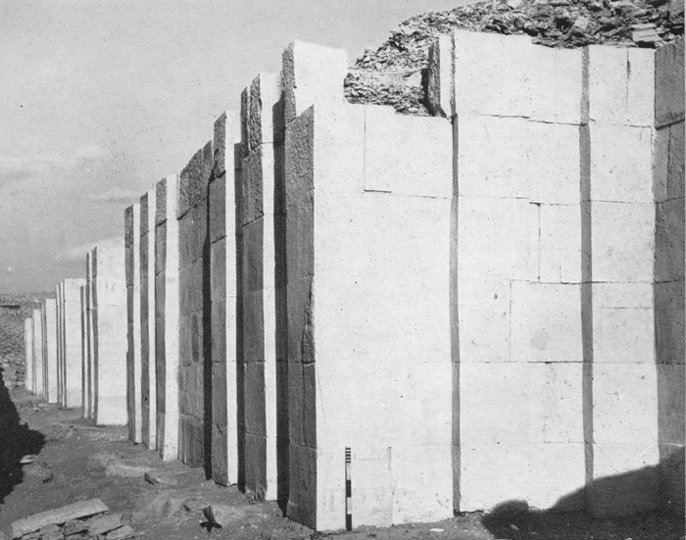
The Step Pyramid was surrounded by a fluted limestone wall. The amazing feature of this wall was that the recesses were chiseled out after the wall had been built.
He then probed the ground to find the four corners. After much digging, he found them and was thus able to define the full area of the complex, whatever it was. It was 1,690 feet (515 m) long and 591 feet (180 m) wide, a larger area than the huge compound of the Step Pyramid! From the fact that it was on lower ground than the Step Pyramid, Zakaria concluded that it had been built later than Zoser’s pyramid, otherwise the builder of this enclosure would have built it on the higher ground.
He felt sure that he was on the track of a pyramid from the missing period between Zoser and Seneferu, the first pyramid builder of the 4th Dynasty. Later, they found a fragment of a boundary stela with the name “Zoser” on it; so, this building had to be later than Zoser.
Now the serious search for the pyramid itself began. Zakaria arranged to build a light railway line to carry away the huge amount of sand and debris that would be involved in unearthing possible buildings, but the search for a tomb entrance in the area they were searching proved to be in vain. In almost despair they looked around for some other possible clue. On New Year’s Day, 1952, they made the great discovery—an enormous wall running east and west across the enclosure. It was of the elaborate curtained type of wall that enclosed the Step Pyramid; again, evidence that they were onto something important, but, strange to say, it was not complete. It did not extend right across the enclosure, only 138 feet (42 m). For some unknown reason, the builders had changed their plans and left this wall incomplete, yet there was evidence that it must have been buried shortly after its construction.
The evidence on which Zakaria based this conclusion was the existence of marks left there by the stone masons. In some places they had stretched a string soaked in red liquid across the face of the stones and twanged them to leave a red line where the stone bulged out, but the stone had never been chipped away to make a level surface. For some unknown reason, the workmen had abandoned this wall without completing the smoothing they had intended to do.
There were also crude inscriptions on some of the stones. Some of these were undoubtedly identifying marks so that the builders using the stones would know where they were supposed to go. One said “this way up,” another “to be taken away,” and yet another “for the royal tomb.”
Some of the crews had also identified themselves as the gang responsible for a particular assignment. One wrote “the crew Cheops excites love.” Another “the crew, the White Crown of Khnumw-Khufu, is powerful.” Another said “the crew Sahure is beloved.” They were no doubt proud of the gang they belonged to and took pride in their workmanship. The idea of foremen flogging slaves to do their pyramid building is completely without foundation, at least in the early dynasties.

Aerial view of the area around the Step Pyramid
- The Step Pyramid and its surrounding wall
- The rectangular area of the Lost Pyramid
- A pyramid enclosure identified by a previous archaeologist
These workmen were very human. In their leisure moments (or was it on the boss’s time?), some of the men indulged in graffiti. In red ochre or lamp-black they drew crude pictures of men, animals, and boats. One man had drawn a picture of a lion, revealing that there must have still been lions prowling the sand dunes at the time of the Old Kingdom.
Zakaria noted the absence of one type of drawing, however, and that is an architect’s plan of the pyramids. He maintains they must have existed because there was nothing haphazard about the ancient Egyptians’ engineering feats, and some such drawings have been found from later dynasties, but none from the Early Kingdom. Time may bring them to light.
So far, so good, but Zakaria points out that up to this time there was still no hard evidence that there was ever a pyramid here. Hints, yes, but he was still longing for something to prove his point. After all, he was spending good antiquities money, and some of his compatriots were embarrassing him by asking, “Where is this pyramid you talked about?”
Then came the first real clue—they found a hole in the ground which had obviously been made by tomb robbers. Now, tomb robbers don’t waste time and energy digging holes in the ground unless they know there is something to dig for. Here was striking evidence that at least there had been a tomb here.
Of course, this also suggested that even if they did find a tomb it was very likely to have been looted of any valuables. Not to worry. Archaeologists are not so much looking for treasures, though it is nice when you find them. They are looking for history; digging up the past and knowledge are more important than “things.”
Zakaria’s men eagerly cleared the tomb robbers’ tunnel, fully expecting it to lead them to the coveted tomb. They followed it for 66 feet (20 m) but then it abruptly stopped. They were confronted with solid rock. It was the end of the tunnel. The tomb robbers had been disappointed, at least with this tunnel. Would Zakaria’s men meet with the same disappointment?
The real breakthrough came on January 29, 1952. Hofni came, all breathless, with the exiting news that the men had uncovered some masonry. Zakaria hurried to the spot, and there it was—a line of hewn stones; undoubtedly the southern lower course of a step pyramid. Unfortunately for them, time had run out. The 1952 digging season had ended and, what was worse, so had the money. To continue the work next season there would have to be a new grant, and at that moment not everyone in the Antiquities Department was convinced that Zakaria had really found a pyramid.
Zakaria had to wait in suspense until November 1953 before a new grant was made and he could continue his work. His men followed the course of stones along until they came to a corner. The inclined style of the corner proved that the structure they had found was indeed a pyramid and not a mastaba.
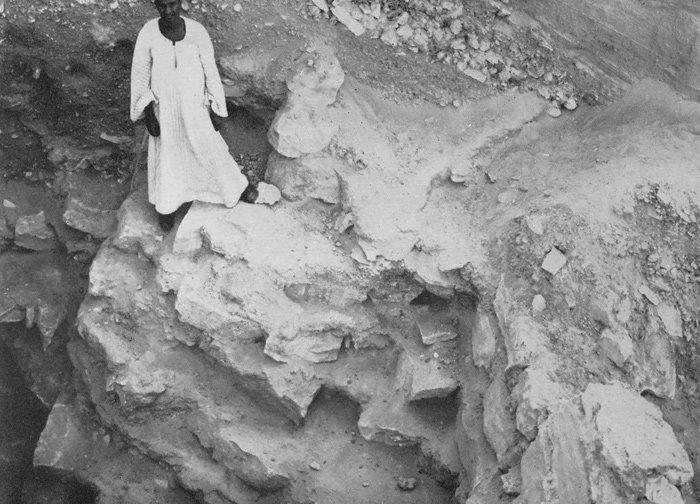
A workman standing on a portion of the north face of the pyramid. The layers of stone incline inward for stability.
Further work exposed the other three corners, and it could now be definitely concluded that they had found a pyramid, but it was only the lower course of a step pyramid. Where were the upper stages? Had the pyramid never been finished, or had it been finished and then dismantled by later builders who wanted some easy stones?
Zakaria concluded that it had never been finished, possibly because of the premature death of the king. The basis for this conclusion was that there were no facing stones on the outside of the stone structure, though perhaps it could just as easily be concluded that stone robbers had taken them also. The remaining height of the pyramid was only about 23 feet (7 m). If completed, it would have been 230 feet (70 m) high, 33 feet (10 m) higher than Zoser’s step pyramid.
Zakaria was able to establish that this pyramid had not been disturbed for some 3,000 years because he found some burials above it that dated to the 19th Dynasty. Actually, he seems to have been happy about the pyramid being so incomplete. He wrote, “A complete pyramid, such as that of Khufu or Menkaure, can tell us little about its internal structure, and the methods by which it was built. An incomplete pyramid such as this one might tell us something.”2
But the big problem was still unsolved. Where was the entrance to the tomb chamber? Zakaria set about finding it.
As most pyramids have their entrances on the north side, he naturally looked there. He uncovered the remains of some buildings there but no sign of an entrance tunnel. Then he noticed a slight depression in the sand some 82 feet (25 m) to the north of the pyramid. He dug there and to his delight found a rock-cut trench. He wrote, “My workmen and I were intensely excited. As we dug down into the sand and more of the trench became visible, it became clear that we were nearing the entrance to the pyramid structure.”3
They proceeded to remove the debris from the trench, but at several points were blocked by thick masonry, which took time to remove. At last they came to a doorway, sealed with masonry. This must be the entrance to the tomb chamber.
The opening of this long-lost tomb was too important an occasion for a humble archaeologist and his workmen to quietly accomplish. On March 9, 1954, the press was summoned, high government officials were invited, and the minister of education was given an axe to strike the first blow that would dislodge the barrier.
With bated breath, the entire company watched while the masonry was removed to reveal an inner passage that undoubtedly led to the tomb chamber. At last, the stones were all removed and at a given signal the entire group surged forward, each one wanting to be the first to catch a glimpse of the sarcophagus that contained the mummy of this long-dead king, but 66 feet (20 m) into the passage they were all stopped in their tracks by a huge pile of rubble blocking their progress. The ceiling had collapsed and filled the tunnel to the height of the ceiling. The dispirited group made their way out into the sunlight and then back to their routine tasks to await further advances by the team of workmen.
During the days that followed, Zakaria and his men laboriously removed the debris, anxiously watching the ceiling for any sign of a further collapse that might entomb the entire work force.
Actually, there was a disaster of a different nature. While the men were clearing the passage, they stumbled on a strange shaft. When they began to clear this shaft, the floor collapsed and some of the men plummeted down to the bottom with debris and sand on top of them. Cries for help brought Zakaria and others to the scene. They frantically tried to remove the debris and recovered most of the buried men unharmed, but one unfortunate worker had been suffocated and was dead.
There was a great wailing from the rest of the men and the women who hurried to the scene. Talk of the curse of the pharaohs at last exacting its revenge passed around, and fear of another possible collapse frightened the men from any further work. It was not until another two weeks had passed that Zakaria was finally able to assuage their fears and entice them back on the job. He had to shore up the roof with timber to ensure there would not be a further collapse.
As they proceeded along the passage, they uncovered an extraordinary collection of stone vessels—hundreds of bowls and cups and dishes of beautiful alabaster. They were not fully hollowed out as they would have been had they been used domestically. They must have been supplied by the artisans for funerary purposes, and what was the point in completing them if no one was going to use them?
Then came the coveted gleam of gold. Zakaria said, “I knelt down and carefully cleared away the clay, recovered 21 golden bracelets and armlets, and a hollow sickleshaped gold wand.”4 He also found a superb cosmetic box and beside it a pair of tweezers and a needle, both made of electrum, an alloy of silver and gold. Apparently, these items had been deliberately left on the floor of the passage, only to be buried when the roof collapsed.
Then came the most important discovery up to that time. It was not gold or silver. It was not ornate or beautiful, but it contained the information an archaeologist desperately hoped for. It was a collection of small pottery jars stoppered with clay and impressed with a seal. The seal impressions bore the name “Sekhem-Khet,” meaning “powerful of body.” It must be the name of the owner of the pyramid.
This was a windfall, but it brought its problems, the principal one being that this king’s name was unknown from any previous king-list. But the work had to go on and the men continued to remove the debris from the tunnel until they had penetrated the passage to a distance of 236 feet (72 m). Then they came to a mass of rock that seemed to be the end of the passage. They looked at each other in despair. Had the king’s men dug this far and then decided to abandon the idea of making a tomb chamber?
Zakaria thought about abandoning the work, at least until the next season of digging, but his trusted foreman, Hofni, urged him on, pointing out that they were now about at the center of the pyramid, a spot where they could expect to find the tomb chamber. Zakaria agreed to go on.
At last, after careful clearing, they were able to penetrate the mass of rock and peer through the small hole they had made. What they saw brought a shout of jubilation. There at last was the tomb chamber, and they could distinctly see a beautiful alabaster sarcophagus. Visions of fabulous treasures filled their thoughts and they eagerly pressed on.
Their first impulse was to lift the lid and peer inside, but they were astonished to find that there was no lid. Moving around to the far end they found a portcullis door which had been slid down to seal the sarcophagus. It had been fastened in place with plaster and would take care and time to open, but at last their ultimate goal was within their reach. Zakaria wrote, “We danced round the sarcophagus and wept. We embraced each other. It was a very strange moment in that dark chamber, 130 feet beneath the surface of the desert.”5
The greatest bonus of all was that there was no evidence of any tomb robbers ever having entered the chamber. “We were the first to enter the sarcophagus chamber since its makers left it.”6
On June 26, the press was once more called and government dignitaries invited. Zakaria triumphantly led them into the trench and along the long passage until they were at last all assembled in the tomb chamber. There was the lovely alabaster sarcophagus, untouched since the day the king was buried there. On top of it were the withered remains of a wreath that had been lovingly placed there by the grieving mourners. A large pulley had been suspended from some sturdy scaffolding, and two hooks had been inserted into the holes in the vertical door, ready for the men to haul it open.
Lights were strategically placed and cameras made ready. Zakaria knelt down and began to chip away at the plaster sealing the door. At last the door was free and Zakaria gave the signal to haul on the ropes. Slowly but surely the door began to rise and Zakaria strained his eyes to catch the first glimpse of the mummy within.
For some seconds there was a stunned silence, and then Zakaria made the astonishing pronouncement: the sarcophagus was empty.
The incredulous bystanders pressed around and bent down to see for themselves. Surely Zakaria had made a mistake, but as each one stood to his feet the awful truth made itself known—the sarcophagus was completely empty. With few words the company filed out in dejection.
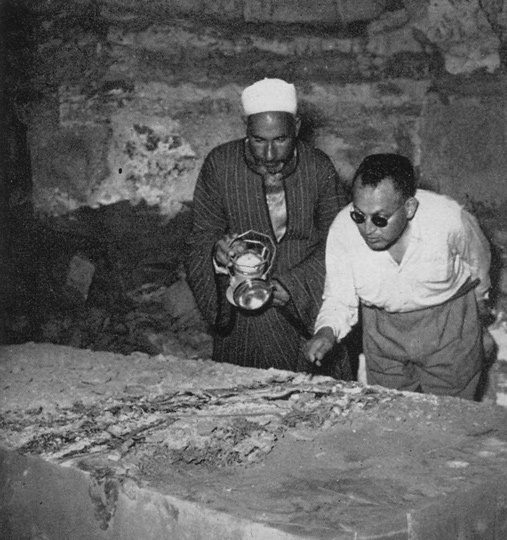
On top of the alabaster sarcophagus a funeral wreath was still preserved to which Zakaria Goneim is pointing.
That is about the end of the story of the Lost Pyramid. To this day, no one can be really sure why anyone would take all this time, trouble, and money to at least commence such a huge undertaking and then never use it. Zakaria could only speculate that the whole thing must have been a dummy burial, and the king had been buried elsewhere, though his real burial place has never been found.
Zakaria points out that there are other instances of dummy burials. The kings of the 1st and 2nd Dynasty have burial places at Saqqara and Abydos. They could not be buried in both places. Seneferu, the first king of the 4th Dynasty, built three pyramids for himself, and not even a god-king can be buried in three places at once.
Zakaria stuck to his story, but the rest of the archaeological world has been left to speculate. The only thing we can be sure of is that the sarcophagus was empty! This whole story gives us an interesting insight into what archaeology is all about.
Unwrapping the Pharaohs
Adults and children alike are fascinated by Egyptian civilization. But most modern archaeologists have lately tried to use Egyptian chronology to dispute the biblical record. Secular textbooks and videos challenge the faith of students and discredit the biblical account of Exodus. Those who wish to defend the accuracy of the Bible now have an incredible tool in this exciting book that provides compelling confirmation of the biblical account.
Read Online Buy BookFootnotes
- M. Zakaria Goneim, The Buried Pyramid (London: Longmans, Green and Co., 1956), p. 25.
- Ibid., p. 56.
- Ibid., p. 77.
- Ibid., p. 89.
- Ibid., p. 100.
- Ibid., p. 104.
Recommended Resources

Answers in Genesis is an apologetics ministry, dedicated to helping Christians defend their faith and proclaim the good news of Jesus Christ.
- Customer Service 800.778.3390
- © 2024 Answers in Genesis

